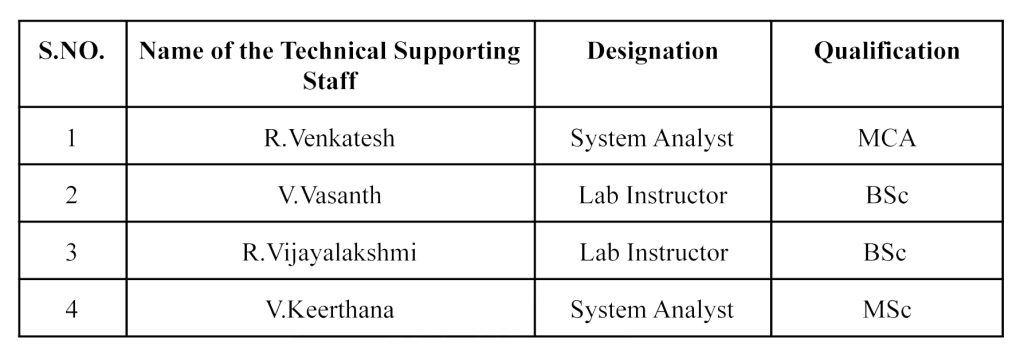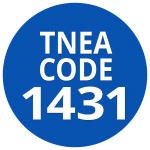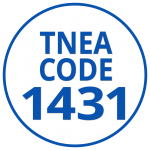| S.No | Faculty Name | Designation |
| 1 | Dr. S.SUBBURAM | Professor / Head |
| 2 | Dr.N.KALYANA SUNDARAM | Professor |
| 3 | M. MAHIMA | Assistant Professor |
| 4 | S. KANMANI JEBASEELI | Assistant Professor |
| 5 | E.JOTHI | Assistant Professor |
| 6 | JANSIRANI.D | Assistant Professor |
| 7 | R. ANITHA | Assistant Professor |
| 8 | U.ESAKKIAMMAL | Assistant Professor |
The computer revolution has geared India towards the new era of growth and technical excellence. Computers have increased the quality, accuracy, efficiency and the speed of the work performed in almost every sector of the activity. Computer helps man in composing, organizing, analyzing, storing and retrieving data with ease and cleans. There is hardly any area of activity that has not been permitted by the magic of the computer . For the every same reason the employment opportunities offered in this sector are phenomenal. IT deals with the use of electronic computers and computer software to convert, store, protect, process, transmit and retrieve information.
In this definition, the term “information” can usually be replaced by “data” without loss of meaning. Recently it has become popular to broaden the term to explictly include the field of electronic communication so that people tend to use the abbreviation ICT (Information and Communication Technology). Today, the term Information Technology has ballooned to encompass many aspects of computing and technology, and the term is more recognizable than ever before. The Information Technology umbrella can be quite large, covering many fields. IT professionals perform a variety of duties that range from installing applications to designing complex computer networks and information databases. A few of the duties that IT professionals perform may include:
- Data Management
- Computer Networking
- Database Systems Design
- Software design
- Management Information Systems
- Systems management
The information technology course provides a comprehensive view of the world of Information Technology including Internet Applications and design, besides the traditional opportunities in Computer Career. Web applications require enormous knowledge of several components like Web servers, Web Protocols and to use the Web Application tools besides OOPS concept. The information Technologist has greater opportunities in Software Development because of their excellent knowledge of Web Technology. In future the IT Industry will purely depend on information Technologists. Besides, job opportunities in the field of technology, other options are the pursuit of higher studies in areas of Networking, Distributed Systems, Web Technologies, Information Systems, Bio Informatics and Artificial Intelligence. The department of information technology was started with the aim of catering to the needs for quality IT professionals in the nations march towards the digital age. The vision of the IT department is to efficiently mould engineer’s knowledge with the theory and practice using teaching skill utilizing the latest practical experiments and software to fit into areas of technology with advanced information.
The department has the following labs as per the requirements of the University. They are:
- Fundamentals of computing Lab
- Object Oriented programming and Data structures lab
- Computer Graphics lab
- Computer Network lab
- Service oriented architecture lab
- Programming and Data structures-II lab
- Web Programming lab
- Case Tools lab
The Department of Information Technology inaugurated the NOTION association on 7th August 2015 as “Techkalam’15” and selected the office bearers. Events like paper presentation and connexions were conducted for the students of the Department who excelled their talents and won prizes. Students visited Radio Astronomy Research Centre (OOTY) as part of their industrial visit program.
The Department of Information Technology, NPSBCET strives to lay new paths to impart an inclusive engineering education by enhancing the potential of students through desire for increased learning and serves the nation by graduating skilled and intellectual IT professionals.
M1: To prepare the students for attaining academic excellence in various dimensions of Information Technology through an innovative teaching learning process.
M2: To nurture basic concepts and latest technologies to students in the right path.
M3: To make our students competent, innovative, go beyond their syllabi and professed problem solvers.
M4: To transform our students into compassionate human beings aware of the societal challenges by imparting quality education and training for creating a better society.
M5: To make our students as tomorrow’s leaders in Information Technology.
PEO 2: To enable graduates to gain employment in organizations and set up themselves as professionals by applying their technical skills to solve real world problems and meet the diversified needs of industry, academia and research by enriching them with the core competencies necessary for applying knowledge of computers and telecommunications equipment.
PEO 3: To enable graduates to think logically, develop hardware and software systems, pursue lifelong learning and will have the capacity to understand technical issues related to computing systems and to design optimal solutions by understanding the importance of social, business and environmental needs in the human context.
PEO 4: To enable graduates to develop hardware and software systems by understanding the importance of social, business and environmental needs in the human context.
PEO 5: To enable graduates to gain employment in organizations and establish themselves as professionals by applying their technical skills to solve real world problems and meet the diversified needs of industry, academia and research.
- Engineering knowledge: Apply the knowledge of mathematics, science, engineering fundamentals, and an engineering specialization to the solution of complex engineering problems.
- Problem analysis: Identify, formulate, review research literature, and analyze complex engineering problems reaching substantiated conclusions using first principles of mathematics, natural sciences, and engineering sciences.
- Design/development of solutions: Design solutions for complex engineering problems and design system components or processes that meet the specified needs with appropriate consideration for the public health and safety, and the cultural, societal, and environmental considerations.
- Conduct investigations of complex problems: Use research-based knowledge and research methods including design of experiments, analysis and interpretation of data, and synthesis of the information to provide valid conclusions.
- Modern tool usage: Create, select, and apply appropriate techniques, resources, and modern engineering and IT tools including prediction and modeling to complex engineering activities with an understanding of the limitations.
- The engineer and society: Apply reasoning informed by the contextual knowledge to assess societal, health, safety, legal and cultural issues and the consequent responsibilities relevant to the professional engineering practice.
- Environment and sustainability: Understand the impact of the professional engineering solutions in societal and environmental contexts, and demonstrate the knowledge of, and need for sustainable development.
- Ethics: Apply ethical principles and commit to professional ethics and responsibilities and norms of the engineering practice.
- Individual and team work: Function effectively as an individual, and as a member or leader in diverse teams, and in multidisciplinary settings.
- Communication: Communicate effectively on complex engineering activities with the engineering community and with society at large, such as, being able to comprehend and write effective reports and design documentation, make effective presentations, and give and receive clear instructions.
- Project management and finance: Demonstrate knowledge and understanding of the engineering and management principles and apply these to one’s own work, as a member and leader in a team, to manage projects and in multidisciplinary environments.
- Life-long learning: Recognize the need for, and have the preparation and ability to engage in independent and life-long learning in the broadest context of technological change.
2. To manage complex IT projects with consideration of the human, financial, ethical and environmental factors , understanding of risk management processes, operational and policy implications.
Technical Supporting Staff

















